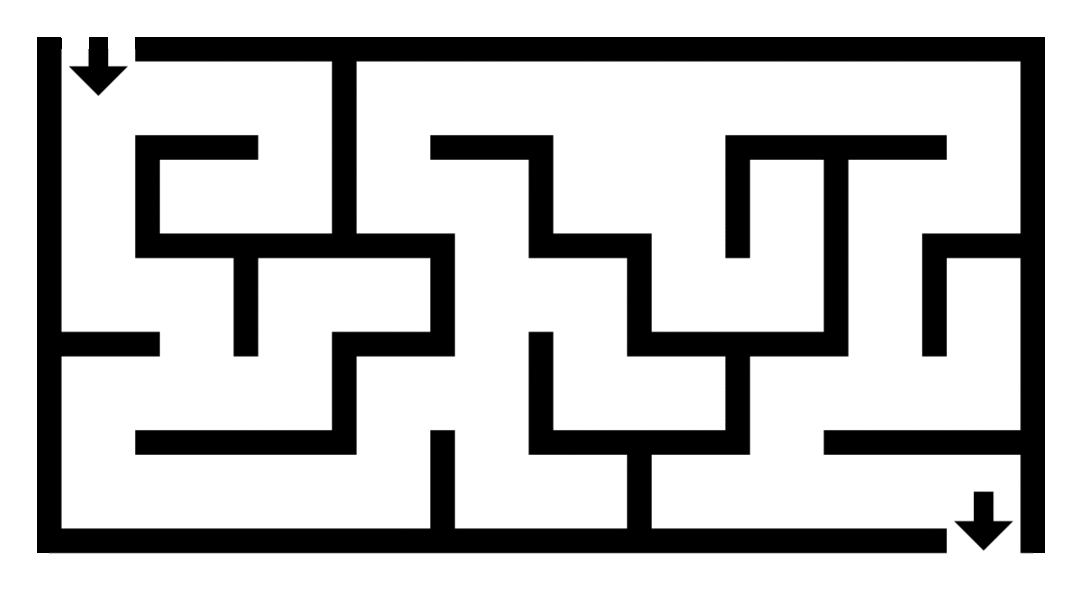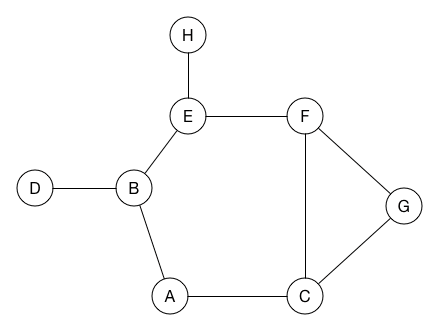# Exam Debrief ## and Maybe Graph Traversals --- CS 137 // 2021-10-20 <!--=====================================================================--> ## Administrivia - Exam 1 and a few daily exercises are graded and will be released immediately after class - <!-- .element: class="fragment"--> Note that DE's are graded on a "GPA" scale - <!-- .element: class="fragment"--> Adding +3 to everyone's exam due to wording issues on my part (mostly on problem 1b and 3) - <!-- .element: class="fragment"--> For those with low scores, decided to calculate final grades as the maximum of two grading scales: 1. <!-- .element: class="fragment"--> Midterm 1 / Final Exam as 20%/20% 2. <!-- .element: class="fragment"--> Midterm 1 / Final Exam as 0%/40% <!--=====================================================================--> # Exam Review <!-- .slide: data-background="#004477" --> <!--=====================================================================--> ## Assignment 2 - To help cement the concepts thus far in the course, I removed the next few daily exercises and released an assignment - <!-- .element: class="fragment"--> The assignment is a deeper investigation into possible solutions to the last problem on the exam <!----------------------------------> <!-- .slide: data-background-iframe="/teaching/2021f/cs137/assignments/assignment-2/" data-background-interactive --> <!--=====================================================================--> # Questions ## ...about anything? <!--=====================================================================--> # Maze Solving <!-- .slide: data-background="#004477" --> <!--=====================================================================--> <!-- .slide: data-background-iframe="https://upload.wikimedia.org/wikipedia/commons/thumb/2/28/Prim_Maze.svg/1200px-Prim_Maze.svg.png" data-background-interactive --> <!---------------------------------->  <!--=====================================================================--> ## Mazes are Just Graphs - Note that a maze can be modeled as a graph - <!-- .element: class="fragment"--> Every "room" is a vertex and every "door" is an edge - <!-- .element: class="fragment"--> Thus, maze solving is equivalent to searching through the paths of a graph <!--=====================================================================--> # Graphs Traversals <!-- .slide: data-background="#004477" --> <!--=====================================================================--> ## Graph Definition - Recall that a **graph** is a linked data structure $G = (V,E)$ where: 1. $V$ is a set of **vertices** 2. $E$ is a set of **edges** - <!-- .element: class="fragment"--> Graphs come in a variety of flavors + <!-- .element: class="fragment"--> Directed/undirected + <!-- .element: class="fragment"--> Weighted/unweighted + <!-- .element: class="fragment"--> Cyclic/acyclic <!----------------------------------> ## Graph Definition <div class='jekyll-diagrams diagrams graphviz'> <!-- Generated by graphviz version 2.43.0 (0) --> <!-- Title: %3 Pages: 1 --> <svg width="332pt" height="162pt" viewBox="0.00 0.00 332.00 161.53" xmlns="http://www.w3.org/2000/svg" xmlns:xlink="http://www.w3.org/1999/xlink"> <g id="graph0" class="graph" transform="scale(1 1) rotate(0) translate(4 157.53)"> <title>%3</title> <polygon fill="white" stroke="transparent" points="-4,4 -4,-157.53 328,-157.53 328,4 -4,4"/> <!-- a --> <g id="node1" class="node"> <title>a</title> <ellipse fill="none" stroke="black" cx="27" cy="-89.53" rx="27" ry="18"/> <text text-anchor="middle" x="27" y="-85.83" font-family="Times,serif" font-size="14.00">a</text> </g> <!-- b --> <g id="node2" class="node"> <title>b</title> <ellipse fill="none" stroke="black" cx="117" cy="-135.53" rx="27" ry="18"/> <text text-anchor="middle" x="117" y="-131.83" font-family="Times,serif" font-size="14.00">b</text> </g> <!-- a->b --> <g id="edge1" class="edge"> <title>a->b</title> <path fill="none" stroke="black" d="M48.85,-100.43C60.03,-106.27 74,-113.57 86.29,-120"/> <polygon fill="black" stroke="black" points="84.81,-123.17 95.29,-124.7 88.05,-116.97 84.81,-123.17"/> </g> <!-- c --> <g id="node3" class="node"> <title>c</title> <ellipse fill="none" stroke="black" cx="207" cy="-66.53" rx="27" ry="18"/> <text text-anchor="middle" x="207" y="-62.83" font-family="Times,serif" font-size="14.00">c</text> </g> <!-- a->c --> <g id="edge3" class="edge"> <title>a->c</title> <path fill="none" stroke="black" d="M53.88,-86.18C84.55,-82.22 135.83,-75.59 170.27,-71.14"/> <polygon fill="black" stroke="black" points="170.91,-74.59 180.37,-69.84 170.01,-67.65 170.91,-74.59"/> </g> <!-- b->c --> <g id="edge2" class="edge"> <title>b->c</title> <path fill="none" stroke="black" d="M135.39,-121.89C148.28,-111.78 166.07,-97.84 180.56,-86.47"/> <polygon fill="black" stroke="black" points="182.94,-89.05 188.65,-80.13 178.62,-83.55 182.94,-89.05"/> </g> <!-- e --> <g id="node5" class="node"> <title>e</title> <ellipse fill="none" stroke="black" cx="297" cy="-20.53" rx="27" ry="18"/> <text text-anchor="middle" x="297" y="-16.83" font-family="Times,serif" font-size="14.00">e</text> </g> <!-- c->e --> <g id="edge5" class="edge"> <title>c->e</title> <path fill="none" stroke="black" d="M228.85,-55.62C240.03,-49.78 254,-42.48 266.29,-36.05"/> <polygon fill="black" stroke="black" points="268.05,-39.08 275.29,-31.35 264.81,-32.88 268.05,-39.08"/> </g> <!-- d --> <g id="node4" class="node"> <title>d</title> <ellipse fill="none" stroke="black" cx="117" cy="-43.53" rx="27" ry="18"/> <text text-anchor="middle" x="117" y="-39.83" font-family="Times,serif" font-size="14.00">d</text> </g> <!-- d->c --> <g id="edge4" class="edge"> <title>d->c</title> <path fill="none" stroke="black" d="M142.51,-49.93C151.57,-52.3 162.01,-55.03 171.78,-57.58"/> <polygon fill="black" stroke="black" points="171.06,-61.01 181.62,-60.15 172.83,-54.24 171.06,-61.01"/> </g> <!-- e->a --> <g id="edge6" class="edge"> <title>e->a</title> <path fill="none" stroke="black" d="M271.76,-13.52C231.77,-3.36 150.38,11.41 90,-16.53 69.12,-26.19 52.7,-46.73 42.01,-63.57"/> <polygon fill="black" stroke="black" points="38.83,-62.08 36.68,-72.45 44.83,-65.68 38.83,-62.08"/> </g> </g> </svg> </div> --- - $V = \\{a, b, c, d, e\\}$ - $E = \\{(a,b),(b,c),(a,c),(d,c),(c,e),(e,a)\\}$ <!----------------------------------> ## Graph Adjacency List <div class='jekyll-diagrams diagrams graphviz'> <!-- Generated by graphviz version 2.43.0 (0) --> <!-- Title: %3 Pages: 1 --> <svg width="332pt" height="162pt" viewBox="0.00 0.00 332.00 161.53" xmlns="http://www.w3.org/2000/svg" xmlns:xlink="http://www.w3.org/1999/xlink"> <g id="graph0" class="graph" transform="scale(1 1) rotate(0) translate(4 157.53)"> <title>%3</title> <polygon fill="white" stroke="transparent" points="-4,4 -4,-157.53 328,-157.53 328,4 -4,4"/> <!-- a --> <g id="node1" class="node"> <title>a</title> <ellipse fill="none" stroke="black" cx="27" cy="-89.53" rx="27" ry="18"/> <text text-anchor="middle" x="27" y="-85.83" font-family="Times,serif" font-size="14.00">a</text> </g> <!-- b --> <g id="node2" class="node"> <title>b</title> <ellipse fill="none" stroke="black" cx="117" cy="-135.53" rx="27" ry="18"/> <text text-anchor="middle" x="117" y="-131.83" font-family="Times,serif" font-size="14.00">b</text> </g> <!-- a->b --> <g id="edge1" class="edge"> <title>a->b</title> <path fill="none" stroke="black" d="M48.85,-100.43C60.03,-106.27 74,-113.57 86.29,-120"/> <polygon fill="black" stroke="black" points="84.81,-123.17 95.29,-124.7 88.05,-116.97 84.81,-123.17"/> </g> <!-- c --> <g id="node3" class="node"> <title>c</title> <ellipse fill="none" stroke="black" cx="207" cy="-66.53" rx="27" ry="18"/> <text text-anchor="middle" x="207" y="-62.83" font-family="Times,serif" font-size="14.00">c</text> </g> <!-- a->c --> <g id="edge3" class="edge"> <title>a->c</title> <path fill="none" stroke="black" d="M53.88,-86.18C84.55,-82.22 135.83,-75.59 170.27,-71.14"/> <polygon fill="black" stroke="black" points="170.91,-74.59 180.37,-69.84 170.01,-67.65 170.91,-74.59"/> </g> <!-- b->c --> <g id="edge2" class="edge"> <title>b->c</title> <path fill="none" stroke="black" d="M135.39,-121.89C148.28,-111.78 166.07,-97.84 180.56,-86.47"/> <polygon fill="black" stroke="black" points="182.94,-89.05 188.65,-80.13 178.62,-83.55 182.94,-89.05"/> </g> <!-- e --> <g id="node5" class="node"> <title>e</title> <ellipse fill="none" stroke="black" cx="297" cy="-20.53" rx="27" ry="18"/> <text text-anchor="middle" x="297" y="-16.83" font-family="Times,serif" font-size="14.00">e</text> </g> <!-- c->e --> <g id="edge5" class="edge"> <title>c->e</title> <path fill="none" stroke="black" d="M228.85,-55.62C240.03,-49.78 254,-42.48 266.29,-36.05"/> <polygon fill="black" stroke="black" points="268.05,-39.08 275.29,-31.35 264.81,-32.88 268.05,-39.08"/> </g> <!-- d --> <g id="node4" class="node"> <title>d</title> <ellipse fill="none" stroke="black" cx="117" cy="-43.53" rx="27" ry="18"/> <text text-anchor="middle" x="117" y="-39.83" font-family="Times,serif" font-size="14.00">d</text> </g> <!-- d->c --> <g id="edge4" class="edge"> <title>d->c</title> <path fill="none" stroke="black" d="M142.51,-49.93C151.57,-52.3 162.01,-55.03 171.78,-57.58"/> <polygon fill="black" stroke="black" points="171.06,-61.01 181.62,-60.15 172.83,-54.24 171.06,-61.01"/> </g> <!-- e->a --> <g id="edge6" class="edge"> <title>e->a</title> <path fill="none" stroke="black" d="M271.76,-13.52C231.77,-3.36 150.38,11.41 90,-16.53 69.12,-26.19 52.7,-46.73 42.01,-63.57"/> <polygon fill="black" stroke="black" points="38.83,-62.08 36.68,-72.45 44.83,-65.68 38.83,-62.08"/> </g> </g> </svg> </div> ```py # Represents a graph as a dictionary (hashtable) that maps # vertices to a list of neighbors (i.e. adjacency list) test_graph = { "a" : ["b","c"], "b" : ["c"], "d" : ["c"], "c" : ["e"], "e" : ["a"] } ``` ```py # gets the neighbors of "a" test_graph["a"] ``` <!-- .element: class="fragment"--> <!--=====================================================================--> ## Graph Traversals - Two common approaches for graph traversals: 1. Depth-first search 2. Breadth-first search - <!-- .element: class="fragment"--> Similar to our maze solving algorithms, both approaches rely on tracking which vertices have already been visited <!--=====================================================================--> # Depth-First Search (DFS) <!-- .slide: data-background="#004477" --> <!--=====================================================================--> ## Depth-First Search - Core idea: + Maintain a **set** of vertices we've seen already + Maintain a **stack** of vertices we've discovered but haven't processed yet + <!-- .element: class="fragment"--> Repeatedly pop a vertex off the stack, push each unvisited neighbor to the stack and seen vertices <!----------------------------------> ## DFS Visualization  <!----------------------------------> ## DFS Pseudocode ```text dfs(g, start) Initialize set D = {start} Initialize stack S = (start) While S is not empty Let u = S.pop() Process the vertex u For each vertex, v, neighboring u If v is not in D Add v to D Push v to S ``` <!----------------------------------> ## DFS Implementation ```py def dfs(g, start): discovered = {start} stack = [start] while len(stack) > 0: u = stack.pop() print(u) for v in g[u]: if v not in discovered: discovered.add(v) stack.append(v) ``` <!--=====================================================================--> ## Using DFS to Solve Problems - Many graph problems reduce to a traversal like DFS - <!-- .element: class="fragment"--> How can we use DFS to solve mazes? <!--=====================================================================--> ## Keeping Track of Paths - It is possible to modify DFS in order to remember the path taken from the starting vertex - <!-- .element: class="fragment"--> Need to remember the **parent** of discovered vertices ```py[2,12] def dfs(g, start): parents = {start : None} discovered = {start} stack = [start] while len(stack) > 0: u = stack.pop() print(u) for v in g[u]: if v not in discovered: discovered.add(v) stack.append(v) parents[v] = u ``` <!-- .element: class="fragment"--> <!----------------------------------> ## Reconstructing Path - Given `parents`, how can we reconstruct the path from `start` to a target vertex `end`? ```py def construct_path(parents, start, end): if end not in parents: # end isn't reachable return None elif start == end: return [start] else: prev = parents[end] path = construct_path(parents, start, prev) path.append(end) return path ``` <!-- .element: class="fragment"--> <!--=====================================================================--> ## Solving a Maze - We now have what we need to solve general mazes: ```py def solve_maze(g, start, end): parents = {start : None} discovered = {start} stack = [start] while len(stack) > 0: u = stack.pop() for v in g[u]: if v not in discovered: discovered.add(v) stack.append(v) parents[v] = u return construct_path(parents, start, end) ```